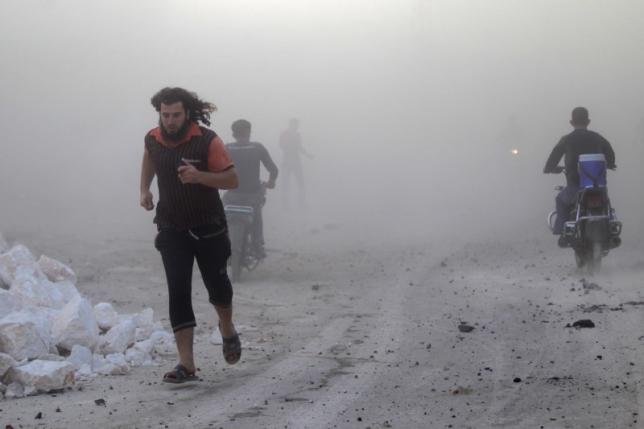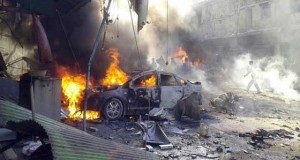www.aljazeerah.info
News, November 2015
Archives
Mission & Name
Conflict Terminology
Editorials
Gaza Holocaust
Gulf War
Isdood
Islam
News
News Photos
Opinion Editorials
US Foreign Policy (Dr. El-Najjar's Articles)
www.aljazeerah.info
|
Editorial Note: The following news reports are summaries from original sources. They may also include corrections of Arabic names and political terminology. Comments are in parentheses. |
Stalemate Still Maintained Between Assad's Government, US-Backed Opposition, and Islamic State in Syria,
November 10, 2015
 |
 |
|
Site of a Russian air strike on the opposition-controlled area of Maaret al-Numan town in Idlib province, Syria October 24, 2015 |
More than 63 people killed and wounded in the two explosions in Lattakia, November 10, 2015 |
More than 63 people killed and wounded in the two explosions in Lattakia
November 10, 2015
Lattakia Province:
The number of people who were killed in the two explosions that rocked the city of Lattakia has risen to at least 23, while more than 40 others wounded, some of them still in critical situation. The first explosion target Sbiro station at the highway of Tishreen university while the other one took place in al- Awqaf area in the city of Lattakia. One of them caused by fall of a rocket shell, while there is contracting information about the second one whether it is caused by explosion of an IED or by a rocket shell.
Continued clashes in Sahm al-Jolan and Russian airstrikes target Homs
November 10, 2015
Dar’a province: Clashes continue between Shohadaa al-Yarmouk against Jabhat al-Nusra and Islamic battalions around Sahm al-Jawlan and near Nafe’a town turning amid mutual bombardment from both sides, casualties reported.
Homs province: A rebel commander was killed by clashes around Talbisa. Russian warplanes targeted areas of Tadmur and the road of Tadmur-Damascus, no reports of losses.
Regime missiles kill more civilians in Duma
November 10, 2015
Reef Dimashq province: Areas of Duma were exposed to missiles bombardment what killed 5 including a child at least and wounded others, reports of more human losses due to the serious injuries. Clashes taking place between regime forces and rebels on Homs-Damascus highway near Duma, Der- Salman, and al-Merej area, amid regime’s bombardment on the area, reports that a religion man was tortured to death with another man in regime prisons after detaining them for months.
24 explosive barrels hit Daraya and Russian airstrikes target Idlib
November 10, 2015
Reef Dimashq province: 24 explosive barrels were dropped on areas of Daraya. Clashes took place between regime forces and rebels around the city of Daraya, no reports of losses. Regime forces fired 2 missiles on Duma city.
Idlib province: Russian airstrikes targeted areas of the industrial area, no reports of losses.
***
Trenches, tactics help rebels survive Syria onslaught
Reuters Fri Oct 30, 2015 9:30am EDT
Trenches, tactics help rebels survive Syria onslaught
BEIRUT/AMMAN | By Tom Perry and Suleiman Al-Khalidi
After the initial shock of intensive Russian air strikes, Syrian rebels on the receiving end of a major offensive say better organization and new tactics have helped them to stem losses and fight back.
A month of Russian air strikes in support of government offensives have cost the rebels in lives and supplies: commanders have been killed, bases bombed, and weapons depleted.
Supported by Iran's Revolutionary Guard Corps and Lebanon's Hezbollah, this is the first multi-pronged attack of its kind in nearly five years of war that have diminished President Bashar al-Assad's control to a quarter or less of Syria.
But while it may be too early to say how this new phase of the war will play out, analysts say modest government gains so far do not appear to match the scale of its assault.
Rebels have even regained some positions, and fighters on the government's side are meanwhile being killed in large numbers, according to the Syrian Observatory for Human Rights, which tracks the war.
Rebels interviewed by Reuters say they are learning to live with Russian air strikes. They are working more closely together and using different tactics to fight back. Knowledge of the terrain is cited as a crucial advantage.
"It's a battle of ambushes, of surprise attacks," said a former army lieutenant-colonel who leads the Jabhat Sham group, a recipient of military support from Assad's foreign enemies that fights under the banner of the Free Syrian Army (FSA).
New supplies of weapons from states including Saudi Arabia and Qatar have arrived, though not in the quantities the rebels would like given the scale of Russian and Iranian intervention.
Still, a steady flow of weapons including anti-tank missiles do appear to be arriving via Turkey. This may increase with Saudi Arabia and the United States promising to bolster support to what they call the moderate Syrian opposition.
The offensives are mostly targeting areas of western and northwestern Syria held by an array of rebels including Free Syrian Army groups backed by Assad's foreign enemies, and jihadists such as al Qaeda's Nusra Front.
ARMY SAYS ATTACK ON COURSE, REBELS GET MORE WEAPONS
A Syrian military source said operations were on track.
"The progress is studied, and happening according to the plan. This plan includes hitting command and communication headquarters, cutting supply routes, thereby keeping the groups in a state of siege," the source told Reuters. He said rebels were waging a propaganda war to maintain their flagging morale.
The war which spiraled from an uprising against Assad has killed about 250,000 people and created more than four million refugees causing crises in Europe and neighboring countries.
One of the biggest government offensives so far is south of the city of Aleppo. A rebel fighting with one of the groups there, the Sham Revolutionary Brigades, said he had never seen anything like the attack that began on Oct. 16.
The attacking forces included 2,500 Iranian and Afghani fighters, and Syrian troops, said Abu Ahmed, the 36-year-old fighter, talking to Reuters from southern Aleppo. Radio intercepts in Farsi gave away the foreign participation.
"What changed for us was the huge, abnormal size, and intensity of the bombardment," said Abu Ahmed, using his nom de guerre and speaking via a web-based messaging system.
His group, another FSA faction which has received foreign military support including U.S.-made anti-tank, or TOW missiles, lost its commander in the fighting. But one week on, Abu Ahmed said the situation had improved.
"Yesterday there was a big Russian air strike, but we organized ourselves, with the rest of the factions. We are used to the new situation," he said. "We camouflage headquarters, and cars, and dig trenches," he said. "But the main factor is counter-moves - such as surprise attacks."
Additionally, the group has been resupplied with TOW missiles which had run out last week, said a member of the group's leadership council, Abu Ahmed Hani. "If (TOW supplies) stay like this then it is great, but the remaining ammunition is not at the required level," he said.
ISLAMIC STATE ATTACK
Most of the ground offensives have targeted northwestern and western Syria, in Hama, Idlib and Latakia provinces, areas where rebel gains this year posed a growing threat to Assad.
While the government has captured some 13 villages, the rebels have recovered three, the Observatory says. More significantly, an attack by Islamic State to the southeast of Aleppo - a response to a government offensive against the group - has threatened a vital government supply route.
The Observatory says more than 350 fighters on the government's side have been killed in the last month, more than the 300 rebels it says have been killed in Russian air strikes. It did not have a figure for the number of rebels killed in ground battles. Reuters has no way to verify the numbers.
"The overall impression is one of a lot of weight being thrown at multiple fronts. Thus far actual regime progress has been modest," said Noah Bonsey, senior analyst with the International Crisis Group think-tank.
"But it is still early to judge where the offensive's top priorities will be, let alone the eventual results."
In the city of Aleppo, the army and its allies are facing the problem that has exhausted rebels in that region for so long: battling two enemies at once, one of them Islamic State. Government forces are trying to break Islamic State's siege of an air base to the east of Aleppo.
TRENCH WARFARE IN LATAKIA HILLS
Russia says its warplanes have hit hundreds of targets, including command centers, and weapons depots. It says insurgents are losing their fighting ability, while their control and supply systems have been disrupted.
After initially portraying its intervention as against Islamic State, Russia has widened the stated targets of its air strikes to include the al Qaeda-linked Nusra Front and Jaish al-Islam, which both operate in western Syria.
But FSA groups, including some that have received training from the U.S. Central Intelligence Agency, have been particularly badly hit. The FSA is a loose alliance of groups, mostly led by army defectors.
"There is a large attrition, particularly of anti-armor weapons," said Abu Hamed, the Jabhat Sham commander.
"The military equipment we have - be it tanks, cars or trucks, is being targeted directly. We lost two cars today."
In the wooded hills of rural Latakia, another focal point of the offensive, trench warfare is helping the rebels to stave off attacks despite their depleted numbers, said Yousef Hifnawi, a fighter in the Ahrar al-Sham rebel group.
"There are people who have not come out of the trenches for more than three weeks," he said.
(Writing by Tom Perry, editing by Peter Millership)
***
Share this article with your facebook friendsFair Use Notice
This site contains copyrighted material the
use of which has not always been specifically authorized by the copyright
owner. We are making such material available in our efforts to advance
understanding of environmental, political, human rights, economic,
democracy, scientific, and social justice issues, etc. We believe this
constitutes a 'fair use' of any such copyrighted material as provided for
in section 107 of the US Copyright Law. In accordance with Title 17 U.S.C.
Section 107, the material on this site is
distributed without profit to those
who have expressed a prior interest in receiving the included information
for research and educational purposes. For more information go to: http://www.law.cornell.edu/uscode/17/107.shtml.
If you wish to use copyrighted material from this site for purposes of
your own that go beyond 'fair use', you must obtain permission from the
copyright owner.
|
|
|
|
||
|
||||||


